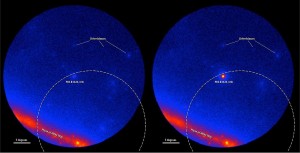Scientists might have found the source of an incredibly energetic particle that bored into the Antarctic ice sheet.

NASA / DOE / LAT Collaboration
Deep in the ice covering the Frozen Continent, scientists have installed a neutrino telescope. Neutrinos are nearly massless particles that zip through space at fair fractions of light speed. They rarely interact with matter; trillions* of neutrinos flew through your body while you were reading this sentence.
Because neutrinos pass through stuff so easily, they don’t get pushed off a straight-line course as they whiz through space. So if scientists can catch them, then they can in principle track the neutrinos back to their origin and learn all sorts of fun stuff about the energetic processes that set the particles loose in the first place.
For example, most of a supernova’s energy is released in neutrinos. So when astronomers first detected neutrinos from space as supernova 1987A lit up our skies, that burst of neutrinos confirmed theories about how a star dies.
But other than that marvelous event, scientists have had trouble finding cosmic neutrinos’ sources. That might — stress might — have changed with a recent paper in Nature Physics.
Searching for a Source
Matthias Kadler (Würzburg University, Germany) and colleagues followed up on one of the biggest blips yet seen by the IceCube Neutrino Observatory. IceCube is a big grid of sensors hung on cables drilled into the Antarctic ice sheet. (Read more about the unique observatory in our January 2014 issue.) When neutrinos pass through the ice, they occasionally smash into an atomic nucleus, creating a cascade of particles and tiny flashes recorded by detectors.
The observatory has detected a few dozen very high-energy neutrinos from space. Two of these — nicknamed Bert and Ernie — had energies of 1 petaelectron volt (PeV), or a thousand trillion electron volts; a third, named Big Bird, came in at double that, with 2 PeV. That’s something like a hundred times more energetic than protons zipping around CERN’s Large Hadron Collider.
Kadler’s team went looking for Big Bird’s origin. They focused on blazars, supermassive black holes girthed by a glowing accretion disk from which they’re powering jets pointed right at us. Blazars could in principle produce super-duper neutrinos, perhaps through a chain reaction involving jet protons and disk photons. But there are so few of the neutrinos, and so few high-energy photons coming from blazars, that it’s hard to confirm both come from the same location. In fact the team had previously considered whether blazars could explain Bert and Ernie, but the work was inconclusive.
Big Bird’s Blazar?
Using data from Fermi and the multi-wavelength monitoring program Tanami, the team looked at known blazars in the patch of Southern Hemisphere sky centered on Centaurus from which Big Bird seemed to come. The researchers found one blazar, PKS B1424-418, that had an extended outburst during the time Big Bird arrived at IceCube. The team calculates that the blazar could have produced the neutrino, with a 5% chance of coincidence.
“Five percent is not a discovery but still an interesting hint,” says IceCube principal investigator Francis Halzen (University of Wisconsin–Madison), who wasn’t involved with the study. Blazars flicker notoriously, so the outburst could have nothing to do with Big Bird. The IceCube team’s own analysis suggests that only 30% of their neutrinos’ sources will match up with Fermi blazars, Halzen says. Still, he adds, “Blazars is an inspired guess,” because the energy observed in cosmic neutrinos matches the overall energy Fermi sees coming from beyond the Milky Way, and most of that gamma-ray flux comes from blazars.
Halzen is hopeful of better odds with a different flavor of neutrino. Neutrinos come in three flavors: muon, electron, and tau. All three of the Sesame Street neutrinos are of the electron variety. Electron and tau neutrinos produce spherical “showers” in the ice that make pinpointing the incoming direction difficult — for now, the team can only narrow it to a region 10º across, he says.
But muon neutrinos passing through Earth make kilometer-long tracks in the detector that scientists can track back to their sources with 0.3º precision. “One [blazar] flare coincident with one of these neutrinos would represent a smoking gun,” he sums up. The team is currently analyzing IceCube’s muon neutrino sample.
* Estimates vary, this is a rough approximation.
References:
Kadler et al. “Concidence of a high-fluence blazar outburst with a PeV-energy neutrino event.” Nature Physics. April 18, 2016.
Govert Schilling. “The Frozen Neutrino Catcher.” Sky & Telescope. January 2014.
 1
1









Comments
May 5, 2016 at 10:04 am
A preliminary version of the article by Kadler et al. is available at http://arxiv.org/abs/1602.02012.
You must be logged in to post a comment.
You must be logged in to post a comment.